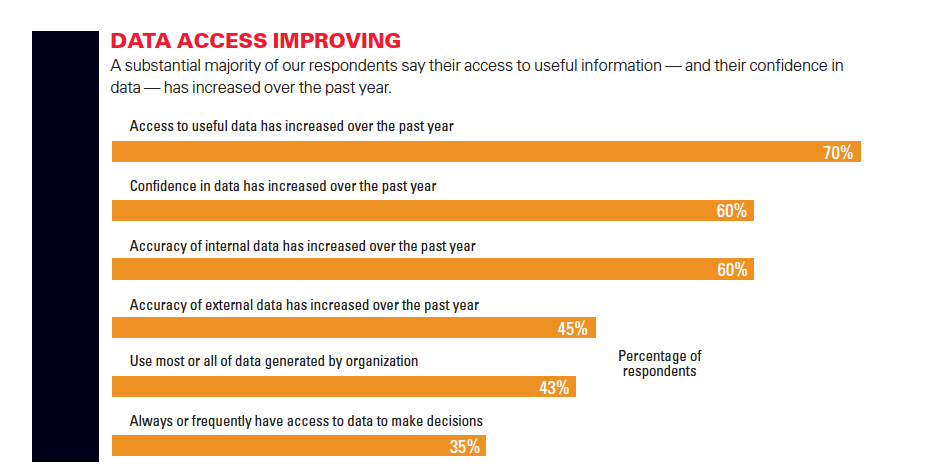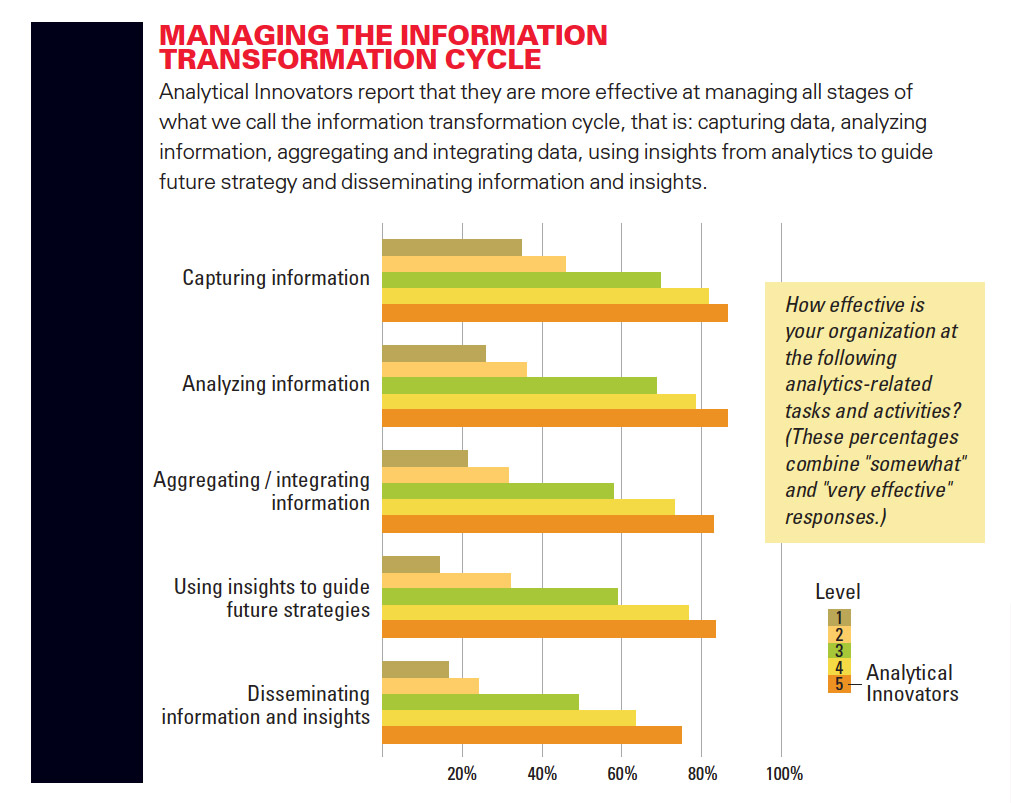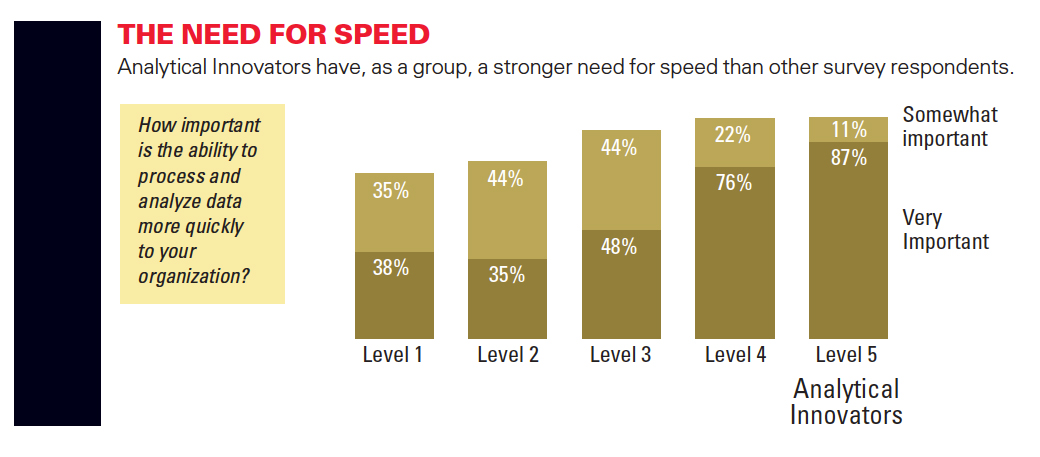Innovating With Analytics
Data-savvy organizations are using analytics to innovate — and, increasingly, to gain competitive advantage.
Topics
Competing With Data & Analytics
Love is a funny thing.
It’s intangible. It’s elusive. It’s illogical, completely beyond quantification.
But that doesn’t stop online dating site Match.com from weaving data science into many aspects of its business. Data analytics influences decisions about everything from the company’s marketing and customer care to its mergers and acquisitions, with one end goal: to help people connect and fall in love.
And many do. According to surveys conducted in 2009-2010 by Match.com, one in five new committed relationships in the United States started online, as had one in six U.S. marriages during the prior three years.1 Match.com is doing its share to increase the ratio. Over the past two years, Match.com has seen more than a 50% increase in revenue, with more than 1.8 million paid subscribers in its core business.
The biggest contributor to Match.com’s recent growth spurt, according to President Mandy Ginsberg, is innovation.2 Several years ago the company began investing in a crack team of data scientists. At the same time, it built out an underlying technology platform that enabled innovation, much of it spurred by data analytics.
Because a dating site is only as good as its ability to connect people, Match.com has a group of data scientists who are continuously improving a series of more than 15 matching algorithms. Their activities underlie the company’s innovative approach to connecting people and support its business advantage in an increasingly competitive market.

Match.com President Mandy Ginsberg said the company has billions of data points it can analyze.
Image courtesy of Match.com.
“Our competition uses a psychological-based methodology and they work closely with psychologists,” said Ginsberg. “Match.com believes that every psychological theory is different, so it becomes difficult to have something that is concrete as opposed to a mathematical equation. We haven’t seen much in the market quite like it. Plus the unique thing about Match.com is that we have billions of data points from the last 17 years to analyze.”
Match.com is among a small but growing cadre of companies — both online and off — that are mastering the use of data and analytics to drive innovation and build competitive advantage.
In a recent data and analytics survey conducted by MIT Sloan Management Review in partnership with SAS Institute Inc., we found a strong correlation between the value companies say they generate with analytics and the amount of data they use, the need for faster results from data, and the ability to operationalize the results within their organizations. (See “About the Research.”) But perhaps the most intriguing finding from the survey is the cultural impact: Some respondents report that the use of analytics is shifting the power structure within their organizations.
The following is a preview of some of our survey’s key findings about topics such as data access, competitive advantage and innovation. More detailed findings from our survey will appear in our full report, to be published in November 2012.
Data Access Data is the foundation of any effective analytics initiative. And with the continued proliferation of data and the relative ease of its capture and storage, organizations now have more information than they ever thought possible. But having the data is not enough.
Data Access Improving

The good news is that a substantial majority of our respondents say their access to useful information has increased over the past year, as has their confidence in data. (See “Data Access Improving.”) However, most organizations use less than half of their data, and even with all that is available to them, just 35% of our respondents say they frequently or always have access to the information they need to make key decisions. But for those who are able to tap into the insights provided by their data, the benefits are substantial.
Competitive Advantage Despite issues with accessing data to make key decisions, 67% of our respondents say that using analytics has created at least a moderate competitive advantage for them. This represents a significant jump from prior surveys.3 In fact, the percentages can’t rise too much further before there is no longer an “advantage.” After all, the idea of an advantage is that someone else doesn’t have it.
Analytics Facilitates Innovation

Innovation Analytics, our survey respondents indicated, can spur innovation. Sixty-one percent of our respondents somewhat or strongly agree that analytics has improved their organizations’ ability to innovate. (See “Analytics Facilitates Innovation.”) The top three areas where analytics has improved innovation are marketing, operations and finance.
Analytical Innovators: In the Forefront
The idea that data and analytics can be used to build competitive advantage and advance innovation is essential to the business models of many online companies, such as Match.com, PayPal, eBay, Amazon and Google. For other companies, data and analytics tend to be a less natural and less essential feature of their strategies for competition and innovation.
By combining responses to two of our questions — one about creating a competitive advantage with analytics and one about using analytics to innovate — we identified five distinct levels of analytics sophistication among survey respondents. The levels ranged from those companies least effective at creating a competitive advantage and driving innovation with analytics (which we call Level 1), to those that seem on their way to mastering the use of analytics in both of these areas (which we call Level 5).
We found that companies where analytics has improved innovation and created a competitive advantage (Level 5 organizations) have several distinguishing features. This group — whom we are calling Analytical Innovators — represents 11% of respondents and includes different-sized companies from a variety of industry sectors and geographic regions.
In general, Analytical Innovators are more likely to use most or all of their data than are other respondent groups, are more likely to be effective at embedding analytics in their organizations, tend to want faster data analysis and, perhaps most interestingly, are more likely than other companies to have seen a power shift within their organizations as a result of analytics. In particular, Analytical Innovators differ from other survey respondents in the following key areas.
Analytical Innovators Tend To Use More Data

1. Analytical InnovatorsTend to Use More Data. A substantial majority of Analytical Innovators say they tend to use much or all of the data their organizations generate. (See “Analytical Innovators Tend to Use More Data.”) This contrasts sharply with the other four groups of organizations we identified. Analytical Innovators are three times more likely to say they use a great deal or all of their data than the 8% of respondents who are the least effective at using analytics for competitive advantage and innovation and whom we call Level 1. More generally, we saw a strong correlation between how much a given company uses analytics to create competitive advantage and advance innovation and how much of their data that company uses.
2. Analytical Innovators Manage Information More Effectively. We also found that there is a strong correlation between driving competitive advantage and innovation with analytics and a company’s effectiveness at managing the information transformation cycle, that is: capturing data, analyzing information, aggregating and integrating data, using insights to guide future strategy and disseminating information and insights. (See “Managing the Information Transformation Cycle.”)
Managing The Information Transformation Cycle

The gap between Analytical Innovators and Level 1 organizations, which innovate with analytics the least and gain the least competitive advantage from analytics, is dramatic across all of these categories. Compared to Level 1 organizations, Analytical Innovators are more than twice as effective at capturing information, more than three times as likely to say they are effective at analyzing information, and more than four times as effective at aggregating and integrating information. Perhaps most noteworthy, Analytical Innovators are six times more likely than Level 1 companies to say that they are effective at using insights from analytics to guide future strategies.
Notice that all respondents tend to be more effective at capturing data than at any other analytics-related activity. Analytical Innovators, however, are the most consistently effective of any group across all categories. For example, Level 1s are twice as likely to say they are effective at capturing data as they are at disseminating insights. Analytical Innovators, by contrast, have less drop-off in effectiveness across these activities.
Getting Insights To The Front Line

We took a closer look at the ability of Analytical Innovators to disseminate insights — specifically, how well they moved insights to customer-facing employees, an extremely valuable activity for many enterprises. Forty-five percent of Analytical Innovators strongly agreed that customer-facing employees in their organization have access to insights from analytics to drive sales and productivity — something they were 7.5 times more likely to report than Level 1 organizations. (See “Getting Insights to the Front Line.”) This characteristic could be one of the ways that Analytical Innovators get a competitive advantage from analytics.
The Need For Speed

3. Speed Is Very Important to Most Analytical Innovators. We also discovered that Analytical Innovators have, as a group, a stronger need for speed than other survey respondents: They are more likely to mark its importance. (See “The Need for Speed.”) Eighty-seven percent of Analytical Innovators report that it is very important to have the ability to process and analyze data more quickly. That’s more than twice the percentage of respondents from Level 1 organizations who report that. Analytical Innovators are primarily focused on utilizing speed in three distinct areas: customer experience, pricing strategy and, notably, innovation.
Analytics Can Shift The Power Structure

Interestingly, Analytical Innovators are also much more likely than other groups to say that analytics has started to shift the power structure within their organizations. Whereas 59% of Analytical Innovators agree somewhat or strongly that there is such a power shift in their organizations, just 7% of Level 1s say the same thing. (See “Analytics Can Shift the Power Structure.”) Consistent with our other findings, the more an organization uses analytics to build competitive advantage and to innovate, the more likely it is to say analytics has shifted its power dynamics.
At PayPal, for example, business analysts — at least a select group of them — are increasingly viewed as ‘thought partners’ who provide not only answers to what to change in the organization, but also how to implement that change. Quantifying impact and leveraging analytics in general are increasingly mandated components of every new PayPal initiative across finance, operations and products, according to Veronika Belokhvostova, director of global business analytics at PayPal.
How a Data-Oriented Culture Changes Organizations
In our survey analysis, we’ve discovered striking differences between Analytical Innovators and their less analytics-driven counterparts. What we found interesting, even surprising, is that Analytical Innovators are not just those companies we would expect — newer, agile online organizations or huge companies with vast analytics investments. Rather, this group represents variously sized companies across industry sectors and geographies. We also identified interesting characteristics shared by Analytical Innovators. They are more likely to use more of their data. They tend to be more effective at driving the information transformation cycle — capturing, analyzing, aggregating, integrating and disseminating information — and thus embedding analytics in the organization. More of them report a greater need for speed in processing and analyzing data.
Perhaps most intriguingly, not only do we see a shift of power with the effective use of analytics, but we also note a marked cultural difference. While many respondents have yet to develop a data-oriented culture, Analytical Innovators as a group tend to score high on those attributes that define such a culture. They tend to be open to new ideas. Customer-facing employees are more likely to have access to data they need. Executives foster analytics-driven decisions, and analytics champions are more likely to exist within these organizations. And more of the companies are able to use analytics to collaborate effectively.
One important takeaway is that a data-oriented culture makes it easier for organizations to innovate when decision makers have confidence in where the data comes from, how it is developed and by whom. But another, perhaps more important takeaway is that Analytical Innovators are not just seeing analytics as an important path to value. Instead, they are evolving and changing as organizations as a result of their experience with analytics.
References (3)
1. Match.com and Chadwick Martin Bailey 2009-2010 surveys, http://cp.match.com/cppp/media/CMB_Study.pdf.
2. “Match.com’s Ginsberg on Subscribers, Strategy,” Bloomberg video, May 20, 2012, www.bloomberg.com/video/70015972-match-com-s-ginsberg-on-subscribers-strategy.html.





Comments (2)
Avoid the Big Data Trap: Four Steps for CEOs | ChiefExecutive.net | Chief Executive Magazine
Dean Malmgren